Crusader castles and bishopric castles in northern Poland
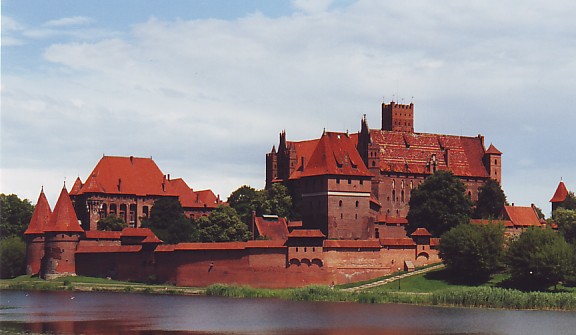
Castle Malbork
Map
over the castle’s location in the new Polish counties (regions): (top left :) Pomorskie and Warminsko-Mazurskie as well as (bottom :) Kujawsko-Pomorskie.
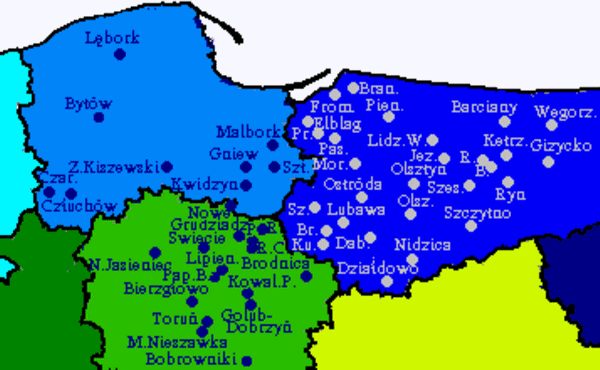
Barciany. -Bezławki. -Bierzgłowo. -Bobrowniki. -Braniewo. -Bratian. -Brodnica. -Bytów. -Czarne. -Człuchów. -Dąbrówno. -Działdowo. -Elbląg. -Frombork. -Giżycko. -Gniew. -Golub-Dobrzyń. -Grudziądz. -Jeziorany. -Kętrzyn. -Kowalewo Pomorskie. -Kurzętnik. -Kwidzyn. -Lębork. -Lidzbark Warmiński. -Lipienek. -Lubawa. -Malbork. -Morąg. -Nidzica. -Mała Nieszawka. -Nowy Jasiniec. -Nowe. -Olsztyn. -Olsztynek. -Ostróda. -Papowo Bishop. -Pasłęk. -Pieniężno. -Pokrzywno. -Przezmark. -Radzyń Chełmiński. -Reszel. -Rogoźno. -Ryn. -Świecie. -Szczytno. -Szestno. -Sztum. -Szymbark. -Toruń. -Węgorzewo. -Zamek Kiszewski
Below is a brief description of the medieval Gothic castles of northern Poland: crusader castles and bishopric, buildings characteristic of these Polish regions, and which today count some of Poland’s major tourist attractions.
Sites where crusader castles are built:
In the historic region of Pomorze Gdańskie (about the present Pomeranian county):
Lębork, Bytów, Czarne, Zamek Kiszewski, Gniew, Nowe, Grudziądz, Swiecie.
In the historic Kujawy region and the Chełmno area (approximately the present Kujawis-Pomeranian county):
Radzyń Chełmiński, Nowy Jasiniec, Lipienek, Kowalewo Pom., Papowo Bishop, Bierzglowo, Toruń, Golub-Dobrzyń, Bobrowniki, Lubawa, Kurzętnik, Brodnica, Bratian, Dąbrówno, Mała Nieszawka, Rogoźno.
In the ancient regions: Warmia and Mazury (roughly the present Warmian-Masurian county):
Elblag, Malbork, Sztum, Pieniężno, Barciany, Pasłęk, Morąg, Lidzbark Warmiński, Jeziorany, Kętrzyn, Węgorzewo, Bezławki, Giżycko, Szestno, Rhine, Przezmark, Szymbark, Ostróda, Barciany
Diocese-built sites:
In Warmia and Mazury:
Frombork, Braniewo, Jeziorany, Kurzętnik, Kwidzyń, Olsztyn, Pieniężno, Reszel.
The individual guarantors:
Barciany
In a swampy area where the river Liwna often crosses its banks, the Prussian tribal barty built a wooden fortress to protect their settlement; later – in the 14th century. – the Crusaders built a walled castle in this place. The castle was built with a northern main wing on two floors for development and a courtyard, which on three sides was surrounded by walls with fortress towers. Among other things. the fortified fortress towers are equipped with slings. The castle was rebuilt several times and lost time – and due to destruction, especially in 1455 – its military importance. Preserved in particular is the east wing with the main gate and the north wing masonry.
photo: http://www.warownia.pl/Tla/Zdj/Barciany1.jpg
Bezławki
Crusader fortress built at the end of the 14th century. The fortress was later converted into a church. Preserved is the floor plan of the castle as well as the lower parts of the walls.
photo: http://www.warownia.pl/Tla/Zdj/Bezlawki1.jpg
Bierzgłowo
Korsidderborg from the end of the 13th century. Of the original castle today, only the gate with the entrance gate from 1305 and the gate of the front gate is preserved.
photo: http://www.warownia.pl/Tla/Zdj/Bierzgl1.jpg
Bobrowniki
The castle was a brick building located on the river Wisła’s wide and built by the Crusaders towards the end of the 14th century. Today, only ruins of the building are found on site.
Braniewo
The castle belonged to the warmish bishops. The castle in Braniewo was demolished in the 19th century after repeated alterations. by order of the Prussian authorities. Today, only the gate tower is preserved. In its time, this building secured the traffic between the lower and upper castles.
photo: http://www.warownia.pl/Tla/Zdj/Braniewo1.jpg
Bratian
This crusader castle was built in the middle of the 14th century. in Gothic style and with a square floor plan. In the 19th century. was the building in severe disrepair. The last building parts were demolished in 1887. Only a few wall fragments with a height of approx. 1 meter is preserved. At the site there is today a mill building.
Brodnica
Korsridderborg built in the first half of the 14th century. Preserved are only the tall tower building, fragments of the gate building and foundations.
Bytów
Korsridderborg from the transition between the 14th and 15th centuries, situated on a high hill overlooking the city. The fortress is built on a square floor plan with an inner courtyard and with four corner towers. The construction work was led by the same architect who designed the grandmasters’ palace in Malbork. The buildings of the castle are preserved as well as defense works and moat. Today the castle houses a museum, the municipal library as well as a stylish hotel.
photo: http://www.warownia.pl/Tla/Zdj/Bytow1.jpg
Czarne
Korsridderborg built at the transition from the 14th to the 15th century, of which today only fragments of the ring wall and the lower parts of the tower are preserved.
Człuchów
This crusader castle, built on a high hill, by a lake, in the middle of the 14th century, was in its heyday compared to the castle in Malbork. The castle was the seat of the area’s comforter (commander or provincial governor; the state of the state was divided territorially into comedies) and consisted of the actual castle (the upper castle) and three fortified suburbs, separated by moat. Of the great castle, today only the high tower and parts of the upper castle are preserved.
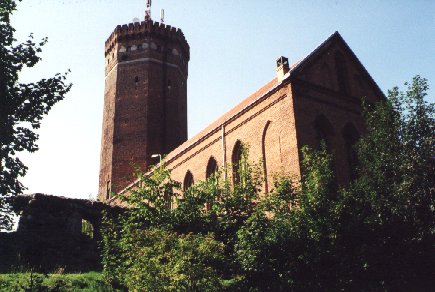
The castle in Człuchów was surrounded by moat, but in 1782 the water level in the lake was lowered by 4 meters and the ditches dried out. Visitors can today hike up to the 46 m high Gothic tower, from whose top there is a panoramic view of the surrounding area. One wing of the castle has been reconstructed. Various events and public performances take place in the courtyard.
photo: http://www.warownia.pl/Tla/Zdj/Czluchow6.jpg
Dąbrówno
Korsridderborg from the 14th century. The building burnt down in 1410, after which a new castle was erected in the 15th century; this building was destroyed during the 1945 war. Ruins exist.
Działdowo
Of the fortified Crusader castle from around 1350, the main building and parts of the defense walls are preserved. The castle was rebuilt in the 16th century; destroyed in 1945.
photo: http://www.warownia.pl/Tla/Zdj/Dzialdowo1.jpg
Elblag
The Crusader Castle was built around the middle of the 13th century. and the city of Elblag was granted market town rights and soon became the most important port city in the Crusaders’ state of law. The castle had a very representative role, since until 1309 it was the seat of the mayor (Landmeister). In 1309, the Grand Master of the Crusader Order moved its headquarters from Venice to Malbork, and the castle of Elbląg became the seat of the Order’s Grand Master of the Order. Residents of Elbląg, hostile to the Crusaders’ rule, conquered the castle in 1454 and tore it down, recognizing the Polish king’s supremacy over the city. Today, only a few buildings from the concourse are used for museum purposes, such as magazines and basements, as well as fragments of the defense walls.
Frombork
The defense system around the fortified cathedral, the canonate and the bishops’ palace emerged in the 14th and 15th centuries. The plant was surrounded by fortress walls. According to tradition, Mikołaj Kopernik (Copernicus) wrote his famous work: “About the orbits of the celestial bodies” in one of the fortress towers.
All the original main elements of the building are preserved. The residence of the Welsh bishops from the 15th century. is today a museum and is available to the public.
photo: http://www.warownia.pl/Tla/Zdj/Frombork3.jpg
Giżycko
In the place where the Baltic tribe of the Jacinians had a fortified city, the Crusaders built a castle in the 14th century. (about 1341). The castle was the seat of the order’s chief prosecutor. The facility consisted of a residential building and a square courtyard, surrounded by walls, behind which were built moat. Of the original buildings today there is the residential building, which has been rebuilt several times over time.
Gniew
On Wisła’On the left bank, the Crusaders began the construction of an impressive castle around 1282. Previously, Gniew belonged to the Cistercian order in Oliwa. The Cistercians had been given the Gniew area by the Pomeranian princes. The Crusader Castle was a four-winged building with an inner courtyard. The plant was surrounded by walls and moat. The Gothic castle’s building mass still dominates the Gniew cityscape. Today the castle houses a hotel and conference center.
photo: http://www.zamek-gniew.pl/main1_zamek.html
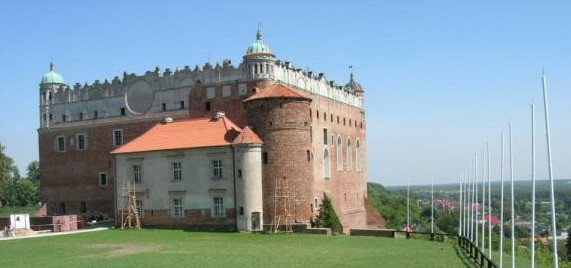
The castle of Golub-Dobrzyń. – Photo Jakob Hoffmann
The castle was built by the Crusaders in the first decade of the 14th century. The building was four-winged with an inner courtyard. In the years 1616-1623, the castle was rebuilt in Renaissance style for the use of Anna Wazowna (Vasa), sister of the Polish and Swedish king, Zygmunt (Sigismund).
Today there is a regional museum, hotel and restaurant in the buildings. Knights tournaments are organized in the courtyard and costumes balls are held in the large halls.
Grudziądz
In the 13th year. the Crusaders built a mighty castle on the banks of Wisła. Construction began with the construction of the main parts of the four-winged castle in the years 1250-1260 and ended in 1299 with the construction of the chapel. Today, only the remains of the defense walls and part of the gate are preserved.
photo: http://www.warownia.pl/Tla/Zdj/Grudz1.jpg
Jeziorany
In the middle of the 14th century. a Gothic castle was built by Bishops Jan I of Meissen and Jan II Styprock. A major fire in 1783 destroyed the entire building. The masonry pieces still standing in 1905 were used at that time to erect the buildings now standing on the premises, which hold public offices. Preserved (as part of the later buildings) are basements, parts of the west wing wall and part of the tower.
Kętrzyn
The Crusader Castle was built in the second half of the 14th century. It was an important seat for order officials and a starting point for outcome against Lithuania. In 1454, the local population revolted and destroyed the castle. The castle was rebuilt in the 17th and 19th centuries, thereby gradually changing its appearance; Among other things, walls and fortress towers were torn down. As a result of the 1945 war, the building burnt down. The castle is now partially reconstructed and houses a museum.
photo: http://www.warownia.pl/Tla/Zdj/Ketrzyn1.jpg
Kowalewo Pomorskie
On a high by a small lake, the Crusader Order built a fortified castle around 1290 – with a square floor plan, courtyard and surrounded by moat. The castle, which was the seat of the Crusader Order (provincial governor) until 1410, was destroyed by the Swedish army at the end of the 17th century. Preserved today are only a few brick walls at the foot of the mound.
Kurzetnik
Around the middle of the 14th century. was built here on a high an Episcopal castle, belonging to the chapel of Chełmno, made of chopped walking blocks and bricks. The plant was traditionally divided into a main castle and a prairie. Destroyed in the 15th century, rebuilt and again destroyed by the Swedes in the 17th century. Today, only the ruins of the walls are preserved.
Kwidzyn
The Diocese of Kwidzyn was built at the beginning of the 14th century, belonging to the Pomesanian Cathedral Chapter. In 1854, a reconstruction of the entire facility was begun, which now houses a museum for the city and the castle. The Kwidzyn Citadel provides an excellent example of medieval defense architecture. The castle is built over a square floor plan, with towers and an inner courtyard with pillars. The castle is connected with the former cathedral, which is now a parish church.
Lębork
At the beginning of the 14th century. For example, the Crusader Order built a small castle, especially for use by the administrative authorities of the Order, built within the fortifications of the city. A mill channel ran through the courtyard. Over time, the building changed its owner and appearance many times. Preserved to this day include the remodeled, two-storey residential building, the castle mill and the original Gothic basements. The main building is today a courthouse.
photo: http://www.warownia.pl/Tla/Zdj/Lebork1.jpg
Lidzbark Warmiński
In the second half of the 14th century, c.1350-1401, a fortified bishopric was built. The castle was built in a building style similar to the crusaders’ castles, and consisted of the capital and the forecourt, the first of which had a large courtyard surrounded by four building wings with archways and corner towers. The castle was the residence of the Warmian bishops. The buildings have been destroyed several times, but have always been rebuilt – even after the recent devastation of World War II. The castle can now be viewed in its entirety – with a few Baroque-style remodels. The building, which today houses the Warmian Museum, is accessible to the public.
photos: http://www.warownia.pl/Tla/Zdj/Lidzbark1.jpg
Lipienek
The Crusader Castle was built by a lake in the early 14th century. The main castle had a courtyard surrounded by walls and attached to the facility was a hideout. It was an important center for the administration and the judiciary. From 1466 Lipienek came into Polish hands and became the seat of the area’s star cheese (approximately = bailiff). Today, only a few wall fragments and cellars are preserved.
Lubawa
The Gothic Diocese of Lubawa was built in the 14th century. (c. 1302-26) by Bishop Arnold as residence of the bishops of the Chełmno area. The building was equipped with a tower and surrounded by walls and moat. Today, only the remains of the ring wall and the granite portal are preserved.
Malbork
The most famous of the buildings mentioned here is the impressive castle of Malbork, one of the most outstanding examples of medieval Gothic defense architecture, erected in brick. After reconstruction of the building parts that were destroyed in 1945, the buildings are now a museum that can be seen in its entirety by tourists.
The castle lies on the right bank of the Nogat River and is surrounded by high fortress walls with gates and towers. The entire castle consists of 3 castles: the High Castle (from the 13th century), the middle castle (built on the former fort in the 14th century) and the lower castle (the front yard; built in the 14th-15th century) .). Malbork was the capital of the Order of the Crusaders from 1309 to 1457 and seat of the Grand Master of the Order. From 1457-1772, the castle was in Polish hands and was the seat of the local starosta as well as the residence of the Polish kings. Among the most interesting spaces in the buildings are: the chapel, the treasury, the refectory (the dining room), 3 chapels and the bedrooms. The entrance to the stronghold passes over a winding bridge, and in the middle of the courtyard is an 18 meter deep well.
photos:
http://www.zamek.malbork.com.pl/index.php?m=01&p=03
Mała Nieszawka
The Crusaders, who had been summoned by the Polish prince, Konrad of Mazowsze, to help fight back the Prussian attacks on Mazowsze, were given the right to establish a secure, temporary settlement on Wisła’s left bank. The order took over several possessions in Kujawy, including in Nieszawa. The first castle from about 1230 was relatively small and made of wood. This one was towards the end of the 13th century. replaced by a larger building, a square facility and associated fortresses – probably the first walled crusader castle on Polish soil.‘s left bank. Archaeological investigations between 1975 and 1980 uncovered fragments of walls and basements as well as moat of the first crusader castle.
Morąg
In the 14th century. a castle was built here that primarily had administrative functions. Today, only minor fragments of the northwest are preserved: the wing, basements, parts of the defensive wall.
Nidzica
The castle in Nidzica was built at the end of the 14th century. (c. 1381-1400) and differs from the previously erected crusader castles. The castle has a more secular than monastic character. The housing facility includes a large residential building. The castle suffered severe destruction during World War II. In the years 1960-1965 the plant was rebuilt.
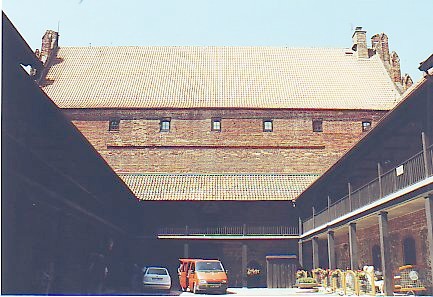
In the spacious courtyard with archways is a 29 m. Deep well. The castle today houses a hotel, café and exhibition halls.
photos: Nidzica . – Nidzica. Zamek prokuratorski
Nowe
This simple crusader castle was built in the second half of the 14th century. Only the residential building is preserved today.
photo: http://www.warownia.pl/Tla/Zdj/Nowe1.jpg
Nowy Jasiniec
This Gothic castle was built at the end of the 14th century. The castle was surrounded by a moat that received water from the castle island. Only parts of the main building’s masonry are preserved today.
Also see: Koronovo / Nowy Jasiniec, here Koronowo.
Olsztyn
The castle of the Welsh bishops was built in the middle of the 14th century. as a seat for the chapter’s administrators. The castle differed with its simple construction plan from the huge crusader castles built up to that time. The castle in Olsztyn consisted of a large residential building and a square courtyard, surrounded by walls. In the years 1516-1521 Mikolaj Kopernik (Copernicus) lived here, acting as administrator of the property of the Warmian cathedral. He personally led the effort to enable the citizen to defend himself against the Crusaders’ attacks in the war waged against the Order in 1519-21. In the 19th century. the Germans demolished the fortifications of the bourgeoisie. Preserved are still the main buildings (3 wing) and the cylindrical tower. Today, the castle houses the Museum of Warmia and Mazury, with archaeological, ethnographic and natural history collections as well as an art collection.
Olsztynek
The Crusader Castle was built in the first half of the 14th century. of Komtur von Hohenstein and had especially administrative functions. In 1410, the castle was conquered by the local inhabitants who surrendered it to the Polish king. The castle has been rebuilt several times due to destruction and has gradually lost its original Gothic character. In the present, the building has housed various public institutions, including a high school.
Ostróda
The crusader castle was built in brick in the middle of the 14th century. as a seat for comets’one. The four-winged building with a square inner courtyard was surrounded by a moat. On the first floor of the south wing was the chapel, refectory and comforter’etc. housing. In the 19th century. the castle was used as a court and office building, part of the rooms, however, for residential purposes.
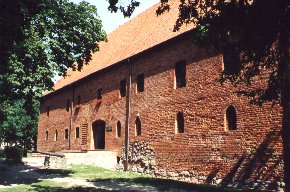
The castle was burned down when the German forces withdrew in 1945. In the post-war period (1974 et seq.) The castle has been rebuilt and now fills the role of cultural center in the city of Ostróda. The buildings thus contain a smaller museum for the history of the castle. The local public library is housed on the first floor of one of the wings. Another wing contains a restaurant. In the courtyard there is an outdoor scene.
Also see: Ostróda
Papowo Bishop
Masonry castle built by the Crusaders at the beginning of the 14th century. The castle was built on a square floor plan and provided with a concourse. Preserved today are only parts of the walls.
Pasłęk
Pasłęk: The building of this crusader castle is completed approx. 1320. The castle was destroyed several times and rebuilt. Most recently, the castle was severely destroyed by a fire in 1945. Today, the castle is partially rebuilt.
Pieniężno
Bispeborg built in the 14th century. Preserved today is a ruined building and ruins of the castle wall.
Pokrzywno
Of the castle from the end of the 13th century. only a few remains of the ring wall and gate tower are preserved as well as the grain storage.
Przezmark
Of the castle from the beginning of the 14th century. Today only a tower and a few remains of the main castle are preserved.
Radzyń Chełmiński
The Crusader Castle was built towards the end of the 13th century. Today, only the south wing wall is preserved with two towers and remains of the walls surrounding the front yard.
Reszel
In the middle of the 14th century, the diocese castle was built on the steep, right bank of the river Sajna. Today, the restored part of the castle houses a hotel, restaurant, cafe, art museum and museum.
Rogoźno
The castle was built towards the end of the 13th century. and was one of the crusader state’s largest civic facilities. Now only the large gate tower and remains of the defensive wall are preserved.
Ryn
The Crusader Castle was built on a ridge between two lakes at the end of the 14th century. The castle has been rebuilt several times and lost its Gothic character; it was destroyed in 1945. Today, the castle is partially rebuilt.
Szczytno
Of this crusader castle from the end of the 14th century. only the remains of the walls are preserved.
Szestno
Of the crusader castle from the end of the 14th century. only the broken basements and insignificant remains of the walls are visible today.
Sztum
This crusader castle was built in the first half of the 14th century and was the seat of the crusader’s administrative authorities. You can still see the main gate, quite large remains of the walls and the lower part of the prison tower.
Szymbark
The castle was built in the second half of the 14th century. as a diocese, but was taken over by the Crusaders. The castle is built on a plot of approx. 6500 m2. and differs greatly from the former Crusader castles. The castle’s architecture joins the ancient tradition. The first castle was built on a rectangular floor plan and had 12 towers. The castle was inhabited until 1945, but burned in 1946. Today the castle is one big ruin.
Pictures:
http://www.ga.com.pl/szymbar1.htm
http://www.ga.com.pl/szymbar2.htm
Świecie
Iecwiecie by Wisła. The castle was built in the middle of the 14th century. on the left bank of the river Wisła. Today, the castle is a ruin where you can see traces of defense works and the moat, outline of the walls as well as a large round tower and a residential wing.
Toruń
The Crusader Castle was built in the second half of the 13th century. It was the first major administrative center for the order on the right bank of Wisła. In 1454 the castle was demolished by the rebellious inhabitants of the city of Toruń and it has never been rebuilt. Today you can see the remains of the castle wall, a tower and a mill.
Węgorzewo
The Crusader Castle was built at the end of the 14th century. and was remodeled several times, thereby losing its defensive character. The castle burned in 1945. The building now houses a hotel.
Zamek Kiszewski
Of this crusader castle, only brick remains from the front door and the gate remain. The ruin is partially under reconstruction.
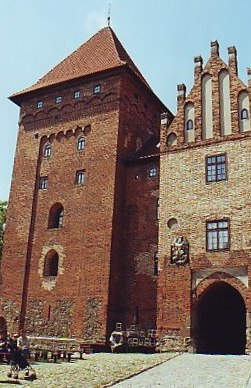
The castle of Nidzica
About the history of the Crusader Order and the castles.
The Gothic castles in the area between Wisła’s lower run (with tributaries) and the Bay of Riga occurred in the 13th to 15th centuries. The number of castles is about 120.
The building of these castles is connected with the militarily strong crusader state at this time.
The crusader state emerged on the land of the Prussian tribes. The Prussians did not have an actual state formation. Society was thus based on tribes and families.
By the end of the 10th year. the Prussian neighbors, Poland and Russia, already had their own states and central authorities. The Prussians, on the one hand, posed a threat to the borders of the new states and, on the other, were an interesting target for conquest. However, fighting this people, who linguistically separated themselves from the Slavic Poles and Russians, was not an easy task because the dense primeval forests and extensive swamps in their territory constituted a natural defense.
The Polish trials in the period up to the 13th century. to gain influence of the Prussians through the introduction of Christianity did not yield. At the beginning of the 13th century. the Cistercian monk Christian undertook a papal-backed mission aimed at Christianizing the Prussians with the help of knights of order. This goal was to be achieved by an armed conquest of the Prussian lands and the establishment of an ecclesiastical state.
This initiative was an obstacle to future Polish influence in the Prussian area.
However, the Polish prince, Konrad Mazowiecki, also undertook activities on his own that aimed to Christianize the Prussians and promote the political influence of the Poles in the area. In this case, Konrad found an ally in a knight’s order originally created to protect pilgrims traveling to the Holy Land. This Order, Order of the Ritter of the Hospital St. Marien des deutschen Hauses, usually called the Order of the Crusaders after the crusade worn by the Order Knights on their robes, settled upon the invitation of Konrad on a land which he had assigned to them, namely the Chełmno area. The knights who came from Thuringia, where they had their property, were the German Emperor Friedrich II’s subjects. In the year 1226, immediately after concluding the agreement with Konrad, they secretly addressed the emperor and were granted a privilege granting the Grand Master of the Order the rights and authority as a prince during the Empire.
This meant that from the beginning the Crusaders intended to create their own state of order.
Already after a few years the Crusaders were successful in the defeat of the Prussians. Although in the first years of the campaign against the Prussians mainly knights from Mazowsze, Kujawy and Pomerania participated, this followed a rapid influx of German knights. In 1234, the pope determined that the lands conquered by the Crusaders were “Saint Peter’s property”. In 1244, the pope created four dioceses and divided the land so that the Order of the Crusaders got two thirds and the bishops the rest.
The defeat of the Prussians with the cross – but first of all with the sword, lasted approx. 50 years. Settlers arrived in the depopulated areas primarily from Germany, but later also from the Netherlands and from Poland: Kujawy, Mazowsze and Podlasie.
During this period, the solidly walled and fortified castles, crusader castles as well as church castles emerged.
The Crusader castles were built partly on sites where the Prussian tribes had previously built fortified settlements, and partly on sites of Slavic origin in Pomerania and Kujawy. All fortifications were built in places where the natural surroundings made access to the castle more difficult. They were built on ridges from which it was easy to spot everyone approaching, on high rivers or in the curves of the rivers, on solid ground surrounded by swamps. The crusaders occupied the fortifications already erected and in a short time they built new, solidly-walled castle of fieldstones and bricks – or exclusively bricks.
Most of the castings were fairly uniform in architectural terms. They were built over a square floor plan with an inner courtyard. The fortress walls either surrounded the entire complex as independent walls or they were part of the basic, square building. It was all surrounded by a moat that was often associated with a river or lake. In the center was the main castle, which among other things. contained the houses of the Order Brothers. Outside the main castle was built a courtyard that contained breeding and other practical purposes; the front yard was also surrounded by a defensive wall. The entrance to the castle passed over a winding bridge and through the gate tower. These gate towers were very high and also served as observation points for the bourgeoisie.
The castles are a prime example of late-medieval architecture, the Gothic. From the outside, these are brick buildings with characteristic retaining walls and pointed arched windows. Indoors are the characteristic ceilings with cross vaults and ribs.
After the Crusaders had built up their strong state in the land of the Prussians, they also tried to submit to nearby lands, both Polish, Lithuanian and Russian.
In 1410 a great battle was fought at Grunwald, where a Polish-Lithuanian army thoroughly defeated a large Crusader army, which, moreover, was assisted by knights from other parts of Europe.
After this defeat, the crusader state still existed for over 100 years.
In 1525, the Crusader Order was dissolved as a result of the Kraków Treaty, and its last Grand Master, Alberg Hohenzollern, became worldly head of the Duchy of Prussia and subject to Poland.
In 1701, the Prussian state emerged from the merger of the Duchy of Prussia and Brandenburg.
Many castles were destroyed during the crusader state’s demise in the middle of the 15th century. In some cases, the ruins were used as a foundation for other, later buildings. Other castles were – because of the solid walls – used as prisons.
Towards the end of the 19th century. Prussian intellectuals began to work for the reconstruction of several of the castles.
Today, too, where it is economically feasible to try, to restore the original appearance of the citizenry.
———————-
Maryla Twardowska-Spangshus
Literature
Guerquin, Bohdan: Zamki w Polsce. Warsaw, 1984. 348 pp., Ill.
Borkowski, Jacek: Zamki Państwa Krzyżackiego. The Burgen im Kreuzritterstaat. Warsaw, 1999. 143 pp., Ill.
links
Organizacja: Polskie Zamki Gotyckie
Zamki in warownie Polski
The Castles of German Order in Prussia
Polskie zamki
Translated into English by Google Translate. Spangshus.dk accept no liability for any errors or omissions in translation.
Search
Most used tags
churches (205) Castles (86) Monasteries (79) Town walls (74) Lakes (71) Town halls (67) Rivers (65) Castles1 (62) Mansions (55) Museums (51) Regional museums (38) Town gates (36) Abbey churches (35) Castle ruins (30) Cathedrals (26) Forests (25) Health resorts (24) Mounds (23) Water sports (23) National parks (22)Click for all tags
Denne side er også tilgængelig på dansk. This page and contents is (c) Copyright 2018- www.spangshus.dk. Based on Inviator software by ISCA Software